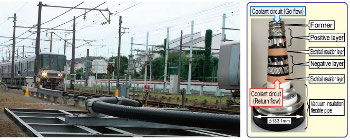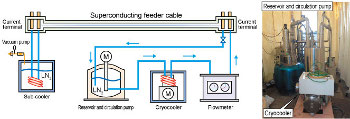17. Production of a 300m class superconducting feeder cable
Before placing superconducting feeder cables into service on railways, several issues have to be resolved and methods found for, among others, laying the cable along the line, mitigating thermal stress which occurs in the cable during cooling, cooling technique to ensure superconducting properties are preserved over a long distance, etc.
A prototype superconducting feeder cable system was laid along the test track at RTRI (Figure 1), and running tests were performed. The system was sized according to the length of a typical feeder section i.e. 310 m, with a rated current of 1000A. In order to reproduce conditions as close to reality as possible, the test line was constructed with a track cross over, a level crossing section and a thermal stress mitigation structure in the cable during cooling.
The running tests were performed after verifying the electrical properties, such as withstanding voltage, of the superconducting feeder cable, and those of the cooling system (Figure 2), which confirmed the conductive properties of the system during operation.
Given the superconducting feeder cable’s capacity to supply electricity with zero electrical resistance, it can be used as a measure to prevent voltage drops and reduce loads on traction substation, etc. Future work is on conducting field tests with the new system, and designing a technical architecture to place the system into active service.


